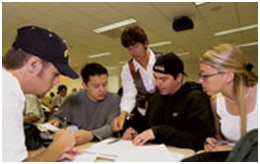The term “high expectations” has become so common in school dialogue that I sometimes wonder if we shouldn’t pause and take time to deepen our common understanding of what it truly looks like when teachers have high expectations for students. An overview of online literature about the topic can produce an array of ways to think about it, such as through school policy, classroom management strategies, and specific instructional techniques. Such paths of discussing expectations are helpful because they extract specific actions for educators based on the roles in which they serve in schools. However, there has been a critical omission in many of the efforts to list what people do when high expectations exist: one that describes the students’ actions in relation to what they are learning.
Such a list can now be found in the Common Core document itself and I recommend its use when educators reflect on their practice. On page 7 of the introduction to the English Language Arts standards, a precise and compelling image of a college and career ready student is offered. According to the document, a student demonstrates qualities of a “literate individual” when he or she can demonstrate increasing capacities in the following actions:
- Demonstrate independence
- Build strong content knowledge
- Respond to the varying demands of audience, task, purpose, and audience
- Comprehend as well as critique
- Value evidence
- Use technology and digital media strategically and capably
- Come to understand other perspectives and cultures
Educators can sharpen their effectiveness by keeping this image of the well-prepared high school graduate in mind. It’s time to bridge the knowing-doing gap among professionals by getting clear about what it looks like when students succeed. I offer two thoughts below that address current barriers to solid implementation of the standards.
Between the lines of school improvement language, the following realities exist, among others:
1) Teachers and administrators need more professional development in the area of text complexity, in thinking beyond grade level reading, and in using the components of text complexity to educate students about their own learning and growth. Teachers need support related to time, resources, information, and collaboration in order to effectively help their students become independent learners.
Boosting implementation of text complexity information would address the common “no one opts out” theory about having high expectations in the classroom. Teachers equipped with appropriate differentiation savvy will see student engagement with texts soar.
2) Many content area teachers need significant support in changing from a direct instruction-one answer approach in “covering” their content standards to a more constructivist, student-driven approach which includes reading, writing, speaking, and listening.
The SREB guide titled, Ten Strategies for Creating a Classroom Culture of High Expectations, lists “the student as worker” and literacy learning strategies as key to holding them engaged in meaningful learning as its strategy number 6.
Some content teachers embrace shifting the work to students more readily than others. Resistance from teachers and students is often not a personality issue, but an efficacy issue, and this fact can get in the way of a common high expectation strategy to provide rigorous coursework for all students. Teachers who are uncomfortable with literacy approaches wonder if their students will learn what they are “supposed” to learn and feel a loss of control in their instructional approach. Just as with students, if proper assistance through modeling, practice, and feedback is not available for teachers’ growth, the change will not happen in effective ways for students.
Much of the “high expectations” literature includes what most of us would call good teaching and learning as well as good leadership strategies. Engaging students in frequent reading, writing, speaking and listening (thinking) about content is certainly not newly introduced in the Common Core, but the urgency and decisiveness with which it is presented is, and that can only help administrators, teachers, and students as they strive to do their work well.
 As Myra Cloer Reynolds succinctly states in the conclusion of the SREB guide, “Motivation, instructional planning, parent engagement, teacher efficacy and consistency of high expectations are irrevocably intertwined. A climate that fosters and values respect, decency and success for EVERY student and staff member is what schools should strive for in their policies and practices.”
As Myra Cloer Reynolds succinctly states in the conclusion of the SREB guide, “Motivation, instructional planning, parent engagement, teacher efficacy and consistency of high expectations are irrevocably intertwined. A climate that fosters and values respect, decency and success for EVERY student and staff member is what schools should strive for in their policies and practices.”
Now educators not only have a helpful list of descriptors to help them discern the actual college and career readiness of their students, but some talking points around which to engage their professional learning dialogue.
Images:
Initial Presentations by by heidigoseek


